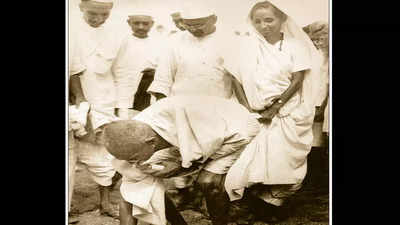- News
- India News
- April 6, the day Mahatma Gandhi broke the British Raj salt laws
Trending Topics
April 6, the day Mahatma Gandhi broke the British Raj salt laws

The Dandi March, also known as the Salt Satyagraha, was a nonviolent civil disobedience campaign led by Mahatma Gandhi in colonial India in 1930. It began on March 12, 1930, and ended on April 6, 1930, with the symbolic breaking of the salt laws by Gandhi.
On April 6, 1930, after walking 24 days and over 240 miles, Gandhi arrived in the coastal town of Dandi, where he and his followers defied British salt laws, to protest the British monopoly on salt production and the taxes they imposed on salt, by making their own salt from seawater.
When they reached the coastal town of Dandi, Gandhi went to the seashore, picked up a handful of salt, and defied the British salt laws by illegally producing salt from seawater.
The breaking of the salt laws was a significant moment in India's struggle for independence from British rule, and it marked the beginning of a new phase in the Indian freedom struggle. This act of civil disobedience was a symbolic gesture that inspired many Indians to join the independence movement and challenge British authority.
Today, April 6 is remembered as a turning point in India's history and a symbol of the power of nonviolent resistance in the face of oppression. It is known as "Salt Satyagraha Day" or "Dandi Memorial Day," to commemorate the event and honor Gandhi's role in India's freedom struggle.
What were British salt laws
The British salt laws were a series of laws and regulations imposed by the British colonial government in India, which made it illegal for Indians to produce or sell salt without obtaining a license and paying a tax to the government.
The salt laws were introduced by the British in the mid-19th century and were part of a broader system of colonial economic exploitation that aimed to extract resources from India and control its economy. The salt tax was one of the most unpopular taxes imposed by the British, as salt was an essential commodity used by Indians in their daily lives and was considered a basic necessity.
The salt laws became a symbol of British oppression in India, and Mahatma Gandhi saw them as an opportunity to mobilize Indians in a nonviolent campaign against British rule. He launched the Dandi March or Salt Satyagraha in 1930, where he and his followers walked over 240 miles to the coastal town of Dandi and broke the salt laws by illegally producing salt from seawater.
The breaking of the salt laws marked a significant moment in India's struggle for independence and helped to galvanize support for the Indian freedom movement. The salt laws were eventually abolished in 1947, when India gained independence from British rule.
How April 6 became a turning point in India’s freedom movement
The Dandi March or Salt Satyagraha was a pivotal event in India's freedom struggle and played a significant role in inspiring and mobilizing Indians to join the nonviolent movement for independence. Here are a few ways in which the events on April 6 inspired India's freedom struggle:
Symbol of defiance: The breaking of the salt laws by Gandhi was a symbolic gesture that showed the world that Indians were willing to challenge British authority and fight for their rights. The act of defiance inspired many Indians to join the nonviolent struggle for independence.
Mass mobilization: The Dandi March was a mass mobilization event that attracted thousands of Indians from all walks of life to join the movement for independence. It helped to create a sense of unity and solidarity among Indians, who had been divided along religious, linguistic, and caste lines.
Nonviolent resistance: The Dandi March demonstrated the power of nonviolent resistance in the face of oppression. Gandhi's emphasis on nonviolence as a means of achieving political change inspired millions of Indians to adopt nonviolent methods in their struggle for independence.
International attention: The Dandi March attracted international attention and helped to garner support for India's struggle for independence from around the world. The global support helped to put pressure on the British government to negotiate with Indian leaders and eventually grant India independence.
Overall, April 6, 1930 was a turning point in India's struggle for independence, and it helped to create a mass movement that ultimately led to India's freedom from British colonial rule.
On April 6, 1930, after walking 24 days and over 240 miles, Gandhi arrived in the coastal town of Dandi, where he and his followers defied British salt laws, to protest the British monopoly on salt production and the taxes they imposed on salt, by making their own salt from seawater.
When they reached the coastal town of Dandi, Gandhi went to the seashore, picked up a handful of salt, and defied the British salt laws by illegally producing salt from seawater.
The breaking of the salt laws was a significant moment in India's struggle for independence from British rule, and it marked the beginning of a new phase in the Indian freedom struggle. This act of civil disobedience was a symbolic gesture that inspired many Indians to join the independence movement and challenge British authority.
Today, April 6 is remembered as a turning point in India's history and a symbol of the power of nonviolent resistance in the face of oppression. It is known as "Salt Satyagraha Day" or "Dandi Memorial Day," to commemorate the event and honor Gandhi's role in India's freedom struggle.
What were British salt laws
The British salt laws were a series of laws and regulations imposed by the British colonial government in India, which made it illegal for Indians to produce or sell salt without obtaining a license and paying a tax to the government.
The salt laws were introduced by the British in the mid-19th century and were part of a broader system of colonial economic exploitation that aimed to extract resources from India and control its economy. The salt tax was one of the most unpopular taxes imposed by the British, as salt was an essential commodity used by Indians in their daily lives and was considered a basic necessity.
The salt laws became a symbol of British oppression in India, and Mahatma Gandhi saw them as an opportunity to mobilize Indians in a nonviolent campaign against British rule. He launched the Dandi March or Salt Satyagraha in 1930, where he and his followers walked over 240 miles to the coastal town of Dandi and broke the salt laws by illegally producing salt from seawater.
The breaking of the salt laws marked a significant moment in India's struggle for independence and helped to galvanize support for the Indian freedom movement. The salt laws were eventually abolished in 1947, when India gained independence from British rule.
How April 6 became a turning point in India’s freedom movement
The Dandi March or Salt Satyagraha was a pivotal event in India's freedom struggle and played a significant role in inspiring and mobilizing Indians to join the nonviolent movement for independence. Here are a few ways in which the events on April 6 inspired India's freedom struggle:
Symbol of defiance: The breaking of the salt laws by Gandhi was a symbolic gesture that showed the world that Indians were willing to challenge British authority and fight for their rights. The act of defiance inspired many Indians to join the nonviolent struggle for independence.
Mass mobilization: The Dandi March was a mass mobilization event that attracted thousands of Indians from all walks of life to join the movement for independence. It helped to create a sense of unity and solidarity among Indians, who had been divided along religious, linguistic, and caste lines.
Nonviolent resistance: The Dandi March demonstrated the power of nonviolent resistance in the face of oppression. Gandhi's emphasis on nonviolence as a means of achieving political change inspired millions of Indians to adopt nonviolent methods in their struggle for independence.
International attention: The Dandi March attracted international attention and helped to garner support for India's struggle for independence from around the world. The global support helped to put pressure on the British government to negotiate with Indian leaders and eventually grant India independence.
Overall, April 6, 1930 was a turning point in India's struggle for independence, and it helped to create a mass movement that ultimately led to India's freedom from British colonial rule.
Start a Conversation
FOLLOW US ON SOCIAL MEDIA
FacebookTwitterInstagramKOO APPYOUTUBE










